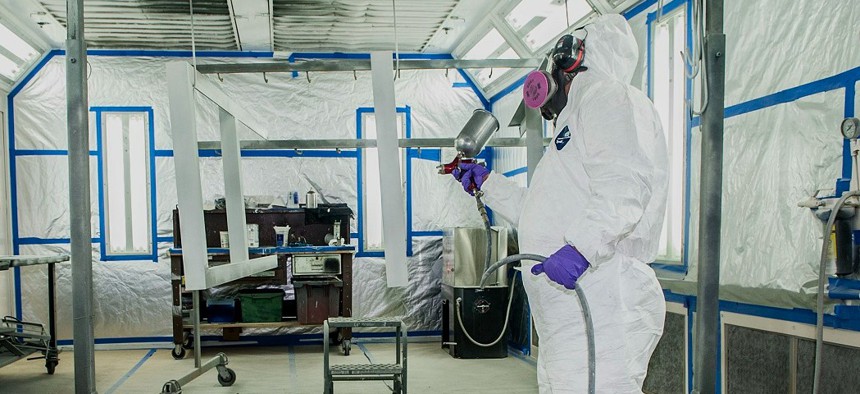Researchers Develop Chemical Agent-Resistant Coatings for Military Equipment

U.S. Air Force photo/Airman 1st Class Jonathan McElderry
Multiple entities are supporting this ongoing effort driving paintable protection.
The Defense Threat Reduction Agency is working with multiple Pentagon components and commercial partners to produce and refine new paint-like coatings that can temporarily shield tactical military equipment from chemical warfare agents, or CWAs.
“We have been exploring ways to make military equipment as easy to clean as possible and prevent [CWAs] from penetrating into standard coatings,” Science and Technology Manager in DTRA’s Protection and Hazard Mitigation Division, Dr. Bernadette Higgins, told Nextgov on Monday. “The military services place a priority on their ability to recover assets after a chemical agent attack and rapidly resume normal operations, free of the burden of individual protective equipment.”
To date, military machinery and battlefield tools have been coated in substances that can provide visual camouflage and corrosion protection. But existing coatings have thus far been unable to offer the most adequate boosted resistance against chemical agents.
“Even very small amounts of CWAs retained in a coating could continue to present hazards that prevent warfighters from removing their protective clothing,” Higgins explained.
DTRA is collaborating directly with the U.S. Combat Capabilities Development Command Chemical Biological Center, Naval Research Laboratory, Army Research Laboratory and multiple industry partners for this program.
The ultimate intent is not to create a unique permanent coating—but instead, officials want to develop, test and improve temporary overcoats that can be sprayed, wiped or brushed on equipment by troops, then work and withstand exposure for at least six months out in the field.
“DTRA has been studying military coatings for many years,” Higgins noted.
Agency insiders have experimented with a range of approaches that have included incorporating repellency into existing coatings, she said, as well as the use of sacrificial, strippable overcoats. They’ve also examined existing coating systems “at a fundamental level,” according to Higgins, to better understand how agents penetrate.
Some of the findings, so far, have been that additives in a coating may make it more susceptible to penetration and that an overcoat has the potential to make the coating system more repellent.
“We have also found through experience that coating properties can deteriorate over time, when exposed to the natural environment,” Higgins said. “Hence, we are calling these coatings ‘temporary,’ because the desired repellency may not last the lifetime of the coating system and could require periodic reapplication.”
In this effort, researchers are leaning on some of the latest advances in polymer synthesis, engineering, and coating formulations to improve both resistance from dangerous chemicals and the decontamination process of painted military surfaces “down to the stainless-steel level.” They are turning to a recently validated test standard known as the Chemical Agent Resistance Method to compare and quantify CWA resistance for existing and in-the-making coating systems.
Tests of newly made overcoats so far have demonstrated a reduction in the amount of absorbed CWAs “by fivefold to a hundredfold,” officials reported, and the coatings worked for more than 8 weeks in normal environmental conditions.
“Our aim is to make the repellency last as long as possible to minimize the need for reapplication and make that reapplication process as easy as possible. At present, we are working closely with industry to examine both developmental and commercially available coatings that perform this function,” Higgins said. “If the overcoats perform better than what we have developed, then we plan to work with industry to adapt them to our needs.”






